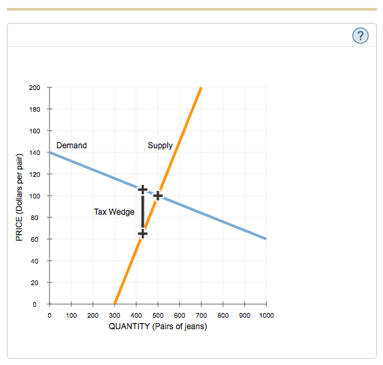Question
The following graph shown the daily market for jeans. Suppose the government institutes a tax of $40.60 per pair. The places a wedge between the
The following graph shown the daily market for jeans. Suppose the government institutes a tax of $40.60 per pair. The places a wedge between the price buyers pay and the price sellers receive.

Fill in the following table with the quantity sold, the price buyers pay, and the price sellers receive before and after the tax.
| Quantity | Price Buyers Pay | Price Sellers Receive | |
| (Pairs of jeans) | (Dollars per pair) | (Dollars per pair) | |
| Before Tax | |||
| After Tax |
Using the data you entered in the previous table, calculate the tax burden that falls on buyers and on sellers, respectively, and calculate the price elasticity of demand and supply over the relevant ranges using the midpoint method. Enter your results in the following table.
| Tax Burden | Elasticity | |
| (Dollars per pair) | ||
| Buyers | ||
| Sellers |
The burden of the tax falls more heavily on the---------- elastic side of the market.
PRICE (Dollars per pair) 200 180 100 140 120 100 80 60 40 20 O + Demand Tax Wedge Supply 0 100 200 300 400 500 600 700 800 900 1000 QUANTITY (Pairs of jeans) (?)
Step by Step Solution
3.54 Rating (147 Votes )
There are 3 Steps involved in it
Step: 1
Values in the graph are not clear so I am taking values written in the graph and market it as A ...
Get Instant Access to Expert-Tailored Solutions
See step-by-step solutions with expert insights and AI powered tools for academic success
Step: 2

Step: 3

Ace Your Homework with AI
Get the answers you need in no time with our AI-driven, step-by-step assistance
Get Started


